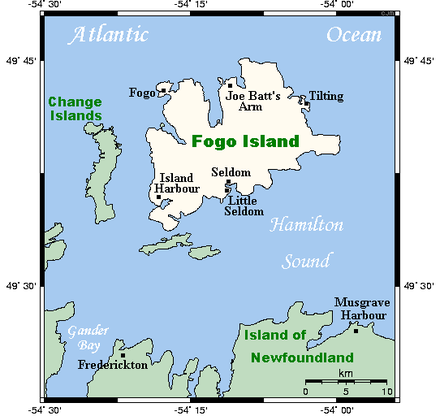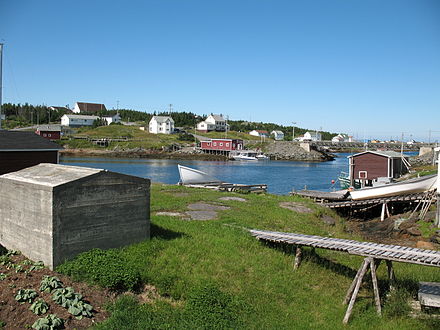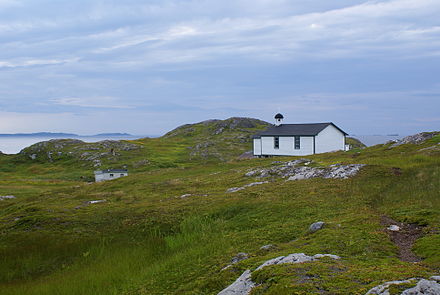Fogo Island and Change Islands - island of Newfoundland and Labrador, Canada
Fogo Island and Change Islands lie off the northeast coast of the island of Newfoundland, Canada.
 Little Fogo Islands and adjacent islands to the southwest comprise about 100 islands strung out in a northeasterly direction. These are the islands that Captain Wadham, in his celebrated sailing directions called “a parcel of dammed rugged isles”.
Little Fogo Islands and adjacent islands to the southwest comprise about 100 islands strung out in a northeasterly direction. These are the islands that Captain Wadham, in his celebrated sailing directions called “a parcel of dammed rugged isles”.
Some 2700 people live on Fogo Island, and 240 people live on Change Islands. Little Fogo Islands are no longer settled.
Communities
Fogo Island is home to 11 communities – each with its own distinctive flare and allure.
- Barr'd Islands
- Deep Bay
- Fogo
- Fogo Island Central
- Island Harbour
- Joe Batt's Arm
- Little Seldom
- Seldom
- Shoal Bay
- Stag Harbour
- Tilting
The Change Islands have one small community, the Town of Change Islands.
Understand
 The isolation from the mainland; the intimate and profound entanglement with the sea and the forces of nature; lives lived at the very edge of a great ocean have created a place of many stories.
The isolation from the mainland; the intimate and profound entanglement with the sea and the forces of nature; lives lived at the very edge of a great ocean have created a place of many stories.
It is not surprising that the Flat Earth Society considers Fogo Island one of the four corners of a flat earth.
Endangered rural communities
Fogo Island and Change Islands were among the earliest European settlements in Canada. They are populated by a people descended from immigrants from the west country of England and Ireland. They have always sustained themselves from the resources of the sea and have developed a vibrant culture based on deeply rooted connections to place and community. Located in the Labrador Current, the Northeast Coast of Newfoundland is the only place in the world where people live in moving ice – as the Arctic pack ice and icebergs are brought to their shores by the south flowing current. To live here is to have an indomitable spirit, a deep understanding of the full community of life, of the give and take of living with the sea and no small sense of humour.
People settled on Fogo Island and Change Islands, like most of Newfoundland, to fish for cod. Cod has sustained people in this place for centuries. In 1992, the government imposed a moratorium and the cod fishery was closed. The upheaval throughout rural Newfoundland was devastating with hundreds of small rural communities – outports – losing their livelihoods almost overnight.

It is a sad reality that many fishing communities are ‘too far gone’ to save. This is not the case with Fogo Island and Change Islands. While the islands suffer from high unemployment, the out-migration of youth and the lack of many of the social and health facilities that most Canadians take for granted, there is no poverty of aspirations. Far from it.
Contemporary art
Fogo Island and Change Islands are known for world-class, cultural programming that attracts people from around the world. The Fogo Island Arts Corporation hosts internationally recognized artists and researchers working in a wide range of disciplines, including visual art, new media, design, fine craft, music, writing and film. It also brings artists and local community members together for workshops, seminars, exhibitions and other events. Arts Corporation activities have two intertwined strands – an international Residency Program and a Production Program. All activities focus on locally rooted and site-responsive themes inspired by Fogo Island’s and Change Islands’ unique geography and people, while reaching out to the international art scene at the same time.
Architecture

Get in
The closest airport for visiting Fogo Island and Change Islands is Gander International Airport. From Gander, take Route 235, the Road to the Isles scenic driving route, to Farewell. A ferry crossing takes approximately 25 minutes from Farewell to Change Islands, or 50 minutes from Farewell to Fogo Island.
Get around
See
Fogo Island and Change Islands offer stunning natural wildlife and scenery such as humpback whales, caribou herds, soaring seabirds, and towering icebergs.
- Bleak House Museum, North Shore Road, Fogo, 49.718°, -54.285°. Home to some of the most powerful and influential people in the history of Fogo, Bleak House represents the differences between the merchant class and the fishing class in the community from a century ago.
- Brett House Museum, Brown's Point Road, Joe Batt's Arm, 49.7296°, -54.1721°. The Brett House and Outbuildings were beautifully constructed, and are exceptionally well-preserved. They were designated as Registered Heritage Structures on October 2, 2003, by the Heritage Foundation of Newfoundland and Labrador.
- Experience Fogo Site, North Shore Road, Fogo, 49.7168°, -54.2895°. Built on the old hospital grounds, view collections of old tools and see how Fogo Islanders grew their own vegetables, raised their livestock, mended their nets, and dried their fish.
- Marconi Wireless Interpretation Centre, Pickett's Road Extension, Fogo, 49.7196°, -54.2631°. Perched high on the hill above the community of Fogo, get a great view of the community and learn about the early communications history of Fogo Island.
- Marine Interpretation Centre, Harbour Drive, Seldom, 49.61°, -54.185°. Restored Fisherman's Protective Union Trading Company building, cod liver oil factory, Funk Island display, interpretation of the Fogo process & Fogo Island Co-op. Touch tank with local sea life. Craft shop, marina, public shower & coin laundry.
Do
- Fogo Walking Trails, Fogo, +1 709 266-3543. Walking trails lead to resettled villages of Lion's Den, Shoal Tickle, Eastern Tickle and Locke's Cove. Also, there are trails to scenic Brimstone Head, Fogo Head and Waterman's Brook.
Eat
- Growlers Ice Cream, 125 Main Road, Joe Batt's Arm, +1 709 266-7982.
- Kwang Tung Restaurant, Main Street, Fogo, 49.7134°, -54.2752°, +1 709 266-2267.
Drink
- Beaches Bar & Grill, 42 Main St, Fogo, +1 709 266-7330.
Sleep
Hotels and motels
- Fogo Island Inn, Joe Batt's Arm, 49.731°, -54.177°, +1 709 658-3444. A cultural destination with 29 guest rooms, each unique, and an art gallery, heritage library, cinema and rooftop sauna. Every detail chosen with purpose and handcrafted by locals. $875-2475 (room only), plus $200/person full board
- Quiet Cannon Hotel, Man O' War Cove, Fogo Island (near ferry dock), 49.574°, -54.300°, +1 709 627-3477. Seasonal restaurant (May-Sep), patio, wi-fi, continental breakfast. Non-smoking, pet-friendly, 13 rooms (incl. 2 efficiency units with kitchens) open year-round. $109 - 164 2017-04-25
Bed and breakfast
- Foley's Place B&B, Kelly's Island Road, Tilting, 49.7074°, -54.0647°, +1 709 658-7244. Four rooms with en-suite bath in century-old home, non-smoking, patio/BBQ, wi-fi. Year-round. $85/night 2016-10-23
- Peg's Bed & Breakfast, 60 Main Street, Fogo, 49.714619°, -54.279743°, +1 709 266-2392. Six rooms, harbour view, wi-fi, full (+$7) or continental breakfast (included). Seasonal (May-Oct). $80-102/night
Guest houses
- Jigloft, 133 Southside Road, Joe Batt's Arm, 49.7310°, -54.1573°, +1 709 730-3700. Restored 150-year-old saltbox home offering clean, comfortable, private self-catering, three-bedroom accommodation in a relaxed & friendly atmosphere.
- The Old Salt Box Co., Various places in Fogo, +1 709 658-7392. Completely renovated, turn of the century, contemporary, ocean front ‘Salt Box Houses’ for rent.
- Quintal House, 153 Main Road, Joe Batt's Arm, 49.7253°, -54.1718°, +1 709 658-7829. Restored three-storey heritage guest home accented with antique and modern functional furnishings and local artisan and craft pieces. Three rooms, all with serene harbour front views.
Connect
Stay safe
Go next
Short of building a ship to set sail for Ireland, Fogo is somewhat of a dead end as it's the northeasternmost point in the area, beyond which is ocean. The only option by car is to get back onto the ferry, same way one came in, back to Twillingate or Lewisporte.
Fogo Island
Newfoundland and Labrador
Primary administrative division